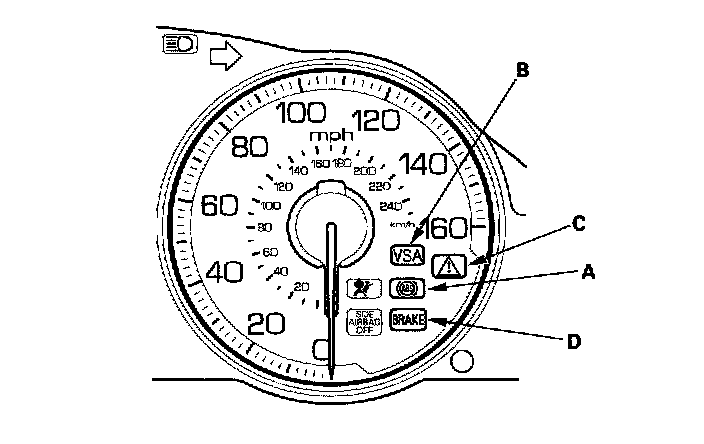Description of On-Board Diagnostics
General Troubleshooting InformationSystem Indicator

This system has four indicators: ABS indicator (A), VSA indicator (B), VSA activation indicator (C) and brake system indicator (D). When the system detects a problem, it illuminates the appropriate indicators. Depending on the failure, the control unit determines which indicators are turned on.
- When ABS function is lost: ABS indicator, VSA indicator and VSA activation indicator turn on.
- When VSA function is lost:
VSA indicator and VSA activation indicator turn on.
- When all functions are lost: All four indicators turn on.
- When the gauge assembly detects F-CAN circuit problem: ABS indicator, VSA indicator and brake system indicator turn on.
ABS/VSA Indicator
- If the system is OK, the ABS and VSA indicators go off 2 seconds after turning the ignition switch ON (II).
- The ABS and VSA indicators come on when the control unit detects a problem in the system.
However, even though the system is operating properly, the indicator may come on under these conditions:
- Only the drive wheel rotates
- One drive wheel is stuck
- The vehicle goes into a spin
- The ABS or VSA continues to operate for a long time
- The vehicle is subjected to an electrical signal disturbance
To determine the actual cause of the problem, question the customer about the problem, taking the above conditions into consideration.
- When a problem is detected and the ABS indicator comes on, but not the VSA indicator, there are cases when the indicator stays on until the ignition switch is turned OFF, and cases when the indicator goes off automatically when the system returns to normal.
- DTC 61 or 62:
The ABS and VSA indicators go off automatically when the system returns to normal.
- DTC 11, 13, 15, 17, 31, 32, 33, 34, 35, 36, 37, 38, 53, 54, 71, 81, 112, 121, 122, 123 or 124:
The ABS and VSA indicators stay on until the ignition switch is turned OFF whether or not the system returns to normal.
- DTC 12, 14, 16, 18, 21, 22, 23, 24, 41, 42, 43, 44, 51 or 52:
The ABS and VSA indicators stay on until the system returns to normal after the vehicle is driven.
- DTC 64, 65, 66, 68, 83, 84 or 86:
The VSA indicator stays on until the ignition switch is turned OFF whether or not the system returns to normal.
Diagnostic Trouble Code (DTC)
- The memory can hold any number of DTCs. However, when the same DTC is detected more than once, the more recent DTC is written over the earlier one. Therefore, when the same problem is detected repeatedly, it is memorized as a single DTC.
- The DTCs are indicated in ascending number order, not in the order they occur.
- The DTCs are memorized in the EEPROM (nonvolatile memory). Therefore, the memorized DTCs cannot be canceled by disconnecting the battery. Do the specified procedures to clear the DTCs.
Self-diagnosis
- Self-diagnosis can be classified into two categories:
- Initial diagnosis: Done right after the ignition switch turned ON (II) and until the ABS or VSA indicators go off.
- Regular diagnosis: Done right after the initial diagnosis until the ignition switch is turned OFF.
- When the system detects a problem, the VSA control unit shifts to fail-safe mode.
Kickback
The pump motor operates when the ABS or VSA is functioning, and the fluid in the reservoir is forced out to the master cylinder, causing kickback at the brake pedal.
Pump Motor
- The pump motor operates when the ABS, or VSA is functioning.
- The VSA control unit checks the pump motor operating during initial diagnosis when the vehicle is driven over 10 mph (15 km/h) the first time after the ignition switch is turned ON (II). You may hear the motor operate at this time, but it is normal.
Brake Fluid Replacement/Air Bleeding
Brake fluid replacement and air bleeding procedures are identical to the procedures used on vehicles not equipped with VSA. To ease bleeding, start with the front wheels.